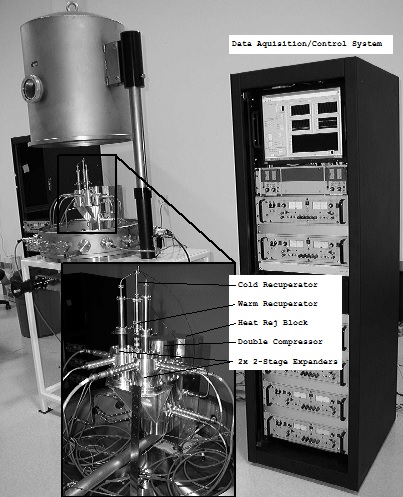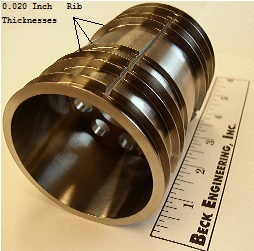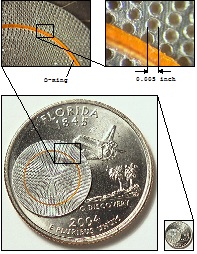Figure 1. Our 35K/85K Cryocooler for the MDA
Figure 2. Titanium 6Al-4V Armature of Figure 3. Disk of Compact High-Performance
Voice-Coil Linear Actuator Cryogenic Heat Exchanger
Double Stirling Multi-Temperature Load Cooler (MTLC). Figure 1 shows a space-based cryocooler designed to provide 1 W of cooling at 35 K and 8 W of cooling at 85 K, which we delivered to the AFRL. Components of the cryocooler represent the state-of-the-art. The compressor uses: (1) voice-coil linear actuators (Figure 2 shows an armature) with optimized magnetic circuits to efficiently generate high pressure swings; and (2) proprietary hybrid hydrostatic/hydrodynamic gas (helium) bearings that have longer operating lives (in theory, infinite) than current flexure bearings. In separate-effects tests, the compressor achieved a pressure swing of 70 psia to 150 psia (0.483 MPa to 1.034 MPa) with an 18.3 cc (1.11 in3) displacement and a 0.355 inch (9.02 mm) stroke. The cold heat exchanger of the 35K/85K cryocooler is more compact than competing heat exchangers by a factor of 15, and compactness is critical for space-based applications. The cold heat exchanger uses 300 recuperator disks to transfer heat between two helium flows. We used high-speed (180,000 RPM) drilling and milling processes to fabricate the heat exchanger disks (see Figure 3). In separate-effects tests, we measured a 99.5% upper bound for the effectiveness of the cold heat exchanger, and a 98.7% lower bound. We used a computational model to calculate 98.9% effectiveness, which is between the measured experimental bounds.
Double Stirling Cooler for Low-Temperature Cooling (100mW at 10K). Under a Phase II SBIR contract with the Air Force Research Laboratory (AFRL), we adapted our MTLC design to design a cryocooler to produce 100 mW of cooling at 10 K, and we built and tested components of the cryocooler.
10W@80K/1W@15K Static-Helium Regenerator/Double Pulse Tube Cooler for Receiving Arrays. Under a Phase I SBIR contract for NASA, we generated a preliminary design and calculated the performance of a Static-Helium Regenerator/Double Pulse Tube Cooler (SHR/DPTC) for receiving arrays. Our SHR/DPTC can be adapted to precool and liquefy hydrogen and/or oxygen. Our SHR/DPTC is contained in a super-insulated tank. Our SHR/DPTC combines two of our technologies that have potential to enable pulse-tube coolers to operate efficiently in the 15-25K range: (1) our Static-Helium Regenerator (SHR) technology, which uses static helium for the regenerator’s thermal mass; and (2) our Double Pulse Tube Cooler (DPTC) technology, which uses a recuperator (instead of regenerators) to transfer heat between two pulse-tube sub-cycles that operate in parallel and out-of-phase.
Voice-Coil Linear Actuator Cryogenic Heat Exchanger
Double Stirling Multi-Temperature Load Cooler (MTLC). Figure 1 shows a space-based cryocooler designed to provide 1 W of cooling at 35 K and 8 W of cooling at 85 K, which we delivered to the AFRL. Components of the cryocooler represent the state-of-the-art. The compressor uses: (1) voice-coil linear actuators (Figure 2 shows an armature) with optimized magnetic circuits to efficiently generate high pressure swings; and (2) proprietary hybrid hydrostatic/hydrodynamic gas (helium) bearings that have longer operating lives (in theory, infinite) than current flexure bearings. In separate-effects tests, the compressor achieved a pressure swing of 70 psia to 150 psia (0.483 MPa to 1.034 MPa) with an 18.3 cc (1.11 in3) displacement and a 0.355 inch (9.02 mm) stroke. The cold heat exchanger of the 35K/85K cryocooler is more compact than competing heat exchangers by a factor of 15, and compactness is critical for space-based applications. The cold heat exchanger uses 300 recuperator disks to transfer heat between two helium flows. We used high-speed (180,000 RPM) drilling and milling processes to fabricate the heat exchanger disks (see Figure 3). In separate-effects tests, we measured a 99.5% upper bound for the effectiveness of the cold heat exchanger, and a 98.7% lower bound. We used a computational model to calculate 98.9% effectiveness, which is between the measured experimental bounds.
Double Stirling Cooler for Low-Temperature Cooling (100mW at 10K). Under a Phase II SBIR contract with the Air Force Research Laboratory (AFRL), we adapted our MTLC design to design a cryocooler to produce 100 mW of cooling at 10 K, and we built and tested components of the cryocooler.
10W@80K/1W@15K Static-Helium Regenerator/Double Pulse Tube Cooler for Receiving Arrays. Under a Phase I SBIR contract for NASA, we generated a preliminary design and calculated the performance of a Static-Helium Regenerator/Double Pulse Tube Cooler (SHR/DPTC) for receiving arrays. Our SHR/DPTC can be adapted to precool and liquefy hydrogen and/or oxygen. Our SHR/DPTC is contained in a super-insulated tank. Our SHR/DPTC combines two of our technologies that have potential to enable pulse-tube coolers to operate efficiently in the 15-25K range: (1) our Static-Helium Regenerator (SHR) technology, which uses static helium for the regenerator’s thermal mass; and (2) our Double Pulse Tube Cooler (DPTC) technology, which uses a recuperator (instead of regenerators) to transfer heat between two pulse-tube sub-cycles that operate in parallel and out-of-phase.


